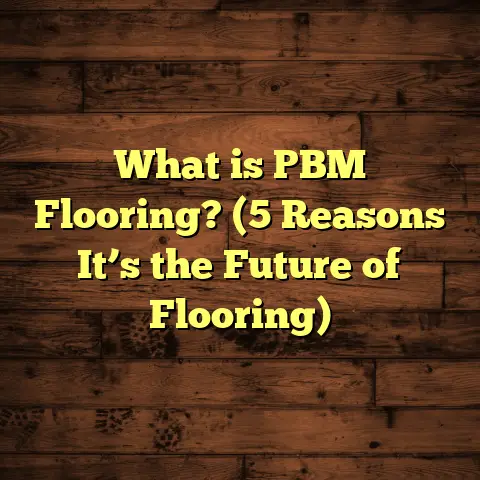What is Vinyl SPC Flooring? (5 Key Benefits You Need to Know)
What is Vinyl SPC Flooring?
Let me start by saying how much I appreciate flooring that’s easy to care for. When you have a busy life, family, pets, or a commercial space, the last thing you want is to spend hours cleaning or worrying about damage. Vinyl SPC flooring fits perfectly into this mindset. But what exactly is it?
SPC stands for Stone Plastic Composite or Stone Polymer Composite. It’s a type of rigid core luxury vinyl flooring made by combining limestone powder (which gives it the stone-like hardness), polyvinyl chloride (PVC) for flexibility and durability, and stabilizers that keep everything stable and long-lasting.
Unlike traditional vinyl flooring, which is somewhat soft and flexible, SPC has a solid, dense core that doesn’t bend or dent easily. Imagine the difference between a flexible plastic sheet and a sturdy, solid slab — that’s the core difference SPC offers compared to regular vinyl.
The surface layer of SPC flooring is a high-definition photographic vinyl layer that can imitate natural materials like hardwood, stone, or ceramic tile with amazing detail and texture you can actually feel. This means you get the look of expensive floors without their high cost or maintenance hassle.
My First Encounter With SPC Flooring
I first got interested in SPC flooring working on a renovation project for a family who needed a floor that could handle heavy foot traffic, spills from kids and pets, and occasional furniture moves. They wanted the warmth and look of wood but without worrying about scratches or water damage.
After installing SPC floors in their living room and kitchen, they told me how much easier cleaning became and how resilient the floors were even after a year of active use. That experience convinced me to explore SPC further and recommend it to many more clients.
How Is Vinyl SPC Flooring Used?
SPC flooring is incredibly versatile. Its water resistance and durability make it popular not only in homes but also in commercial environments.
Residential Applications
In homes, SPC is perfect for:
- Kitchens: Where spills are frequent and moisture is common.
- Bathrooms: The waterproof nature prevents warping or swelling.
- Basements: Often damp or humid areas where wood or laminate floors fail.
- Entryways and Mudrooms: Resistant to dirt, moisture, and wear from shoes.
- Living Areas: Especially in homes with kids or pets needing durable surfaces.
One client installed SPC flooring throughout their entire main floor because it held up beautifully to their toddler’s constant spills and their dog’s energetic running.
Commercial Uses
SPC floors are also gaining traction in commercial spaces like:
- Retail stores
- Restaurants and cafes
- Offices
- Medical facilities
Their durability means they stand up to heavy foot traffic and occasional drops or spills without needing costly repairs or replacements. The ease of maintenance also helps commercial clients save on janitorial costs.
Outdoor Applications?
While SPC is not designed for outdoor use exposed to direct sunlight or extreme weather, it works well in covered patios or sunrooms where moisture resistance is needed but full weatherproofing isn’t required.
Installation of Vinyl SPC Flooring: What You Should Know
Installing SPC flooring is one of the reasons I like recommending it—it’s straightforward and fast.
Click-Lock System
Most SPC planks come with a click-lock mechanism where planks snap together without glue or nails. This floating floor installation system makes the process cleaner and faster.
For a 500 sq ft room, my crew can usually install the floor in a day or two depending on the room’s complexity.
Subfloor Preparation
Before installation, preparing the subfloor is critical. It should be:
- Flat (level within 3/16 inch over 10 feet)
- Clean (free from dust, dirt, debris)
- Dry (especially important on concrete slabs)
Uneven surfaces can cause gaps or create stress points where planks might separate over time.
Acclimation Period
One tip I learned through trial and error: let your SPC planks acclimate at room temperature for 48 hours before installation. This allows them to expand or contract with ambient temperature and humidity changes, reducing future issues.
Tools Needed
Unlike hardwood which requires saws and nailing guns, installing SPC involves:
- Measuring tape
- Utility knife or saw for cutting planks
- Rubber mallet
- Spacers to leave expansion gaps around edges
DIY vs Professional Installation
Many homeowners successfully install SPC themselves because of its user-friendly system. However, irregular room shapes, thresholds, or stairs may need professional expertise for a flawless finish.
Maintaining Your Vinyl SPC Flooring
Maintenance is where SPC flooring shines for me.
Regular Cleaning
I recommend sweeping or vacuuming regularly to keep grit off the surface that can cause scratches over time. Use a vacuum without a beater bar to protect the wear layer.
Wet Cleaning
For spills or stains:
- Use a damp mop with warm water and mild detergent.
- Avoid soaking the floor with excessive water.
- Never use abrasive scrubbers or cleaners as they can damage the finish.
I’ve seen clients spill wine or coffee without staining their floors because cleanup was quick and easy.
Stain Resistance
SPC floors resist stains better than many other flooring types—especially compared to carpet or untreated hardwood. If stubborn spots appear (like ink or paint), some gentle scrubbing with recommended vinyl cleaners usually removes them.
Preventive Care
Place felt pads under furniture legs to avoid dents. Use area rugs in high traffic zones like entryways to minimize wear.
Trim your pets’ nails regularly as sharp claws can scratch even tough surfaces over time.
Long-Term Durability
Unlike hardwood floors that require refinishing every few years, when an SPC plank gets damaged, you can replace just that plank without tearing up the entire floor—saving money and effort.
Five Key Benefits You Need to Know About Vinyl SPC Flooring
1. Durability That Lasts
I’ve installed hundreds of square feet of SPC flooring in various environments—from family homes to retail stores—and one thing stands out: the toughness.
SPC’s stone composite core gives it excellent impact resistance. According to tests by FloorScore certification programs:
- SPC can withstand impacts over 1800 grams without cracking.
- It resists scratches from keys, pet claws, and furniture dragging better than laminate floors.
In one retail project I managed, after 18 months of heavy use with shopping carts and dropped items, the floor showed almost no signs of wear.
2. Waterproof and Moisture Resistant
This benefit alone makes SPC priceless in wet areas.
Waterproof core means:
- No swelling or warping from spills or humidity.
- Great option for bathrooms, kitchens, basements.
According to research by the Resilient Floor Covering Institute (RFCI), SPC floors can tolerate up to 24 hours of standing water exposure without damage—far superior to laminate or hardwood.
One client told me about a burst pipe incident in their basement where SPC flooring prevented any lasting damage. They just dried it quickly, and the floor stayed intact.
3. Easy Installation Process
The click-lock system not only saves time but reduces mess compared to glue-down vinyl or tile installation.
On average:
- Installation takes 30–50% less time than traditional hardwood floors.
- No drying time like with adhesives.
I remember installing an entire 1,200 sq ft office floor in two days with minimal disruption to daily business operations—a huge win for my client.
4. Realistic Aesthetic Options
SPC flooring comes in countless designs that replicate wood grains, stones, marbles, slate, and more—all with textures you can feel.
Modern printing technology combined with embossed finishes makes these floors visually striking and authentic-looking.
I recently helped a client match their farmhouse décor with rustic oak SPC planks that looked almost indistinguishable from real hardwood at half the cost.
5. Cost-Effective Flooring Solution
When you factor in purchase price plus installation and maintenance costs over time, SPC flooring proves highly economical.
Typical costs per square foot (materials + installation):
| Flooring Type | Average Cost per Sq Ft |
|---|---|
| Vinyl SPC | $4 – $9 |
| Engineered Hardwood | $7 – $14 |
| Natural Stone Tile | $10 – $25 |
With durability and low upkeep needs factored in, many homeowners save thousands over years compared to hardwood or tile.
More Detailed Insights From My Experience
Here are some valuable lessons I’ve gathered over years working with SPC flooring:
Sound Absorption Qualities
One surprising benefit I noticed installing SPC in several offices was its ability to reduce noise transmission compared to laminate or tile floors. The dense core absorbs footstep sounds better than thin vinyl sheets.
This makes it great for apartments or multi-story homes where noise control matters.
Temperature Resistance
SPC performs well under radiant heating systems since it doesn’t expand or contract as much as wood floors do. One of my clients installed it over underfloor heating with zero warping issues even after winters.
Environmental Considerations
Though made from PVC (a plastic), many manufacturers now produce SPC products free from harmful phthalates and comply with strict indoor air quality standards (FloorScore certification).
Choosing SPC certified for low VOC emissions helps maintain healthy indoor environments—something I always suggest clients check before buying.
Case Study: Commercial Café Flooring With SPC
A local café chain hired me to replace their worn-out tile floor with something durable yet stylish. They needed:
- Waterproof flooring due to regular mop cleaning
- Scratch resistance from moving chairs and tables
- A look that matched their modern rustic brand image
- Quick installation minimizing downtime
After evaluating options, we chose an SPC floor with textured stone pattern planks featuring a matte finish for slip resistance.
Results after 12 months:
- Zero visible wear despite daily foot traffic exceeding 300 customers.
- Maintenance costs cut by nearly half compared to previous tile floors.
- Positive customer feedback on aesthetics.
- Staff appreciated ease of cleaning and quick mop-dry cycles after spills.
This project highlighted SPC’s value in commercial settings beyond just residential use.
Comparing Vinyl SPC Flooring With Other Popular Options
To help you decide if SPC is right for your project, here’s how it stacks up against other popular floors:
| Feature | Vinyl SPC | Laminate Flooring | Engineered Hardwood | Ceramic Tile |
|---|---|---|---|---|
| Water Resistance | Fully waterproof | Water-resistant but swells if soaked | Sensitive to moisture | Waterproof |
| Durability | High | Moderate | Moderate | Very high |
| Installation | Click-lock (DIY friendly) | Click-lock | Nail/glue down (professional) | Thinset mortar required |
| Appearance | Realistic wood/stone looks | Good wood look | Natural wood | Wide design variety |
| Maintenance | Easy (sweep & damp mop) | Easy | Requires polishing/refinishing | Grout cleaning required |
| Cost per Sq Ft | $4–$9 | $2–$6 | $7–$14 | $5–$20+ |
| Noise Level | Quiet underfoot | Can be hollow sounding | Warm sound | Hard & echo prone |
Tips for Choosing the Right SPC Flooring for Your Project
Here are some practical tips based on my experience:
- Check Wear Layer Thickness
The wear layer protects the printed vinyl surface. For residential use, choose at least 20 mils; for commercial spaces, 30 mils or more is better. - Look for Certifications
Choose products certified by FloorScore or similar bodies ensuring low VOCs and safe indoor air quality. - Consider Underlayment
Some SPC floors come with attached underlayment for sound absorption; if not, consider adding one separately especially on concrete slabs for comfort and noise reduction. - Match Design With Your Space
Take samples home to see how colors look under your lighting before buying large quantities. - Plan for Expansion Gaps
Always leave manufacturer-recommended gaps around walls during installation to allow for natural expansion/contraction.
Frequently Asked Questions About Vinyl SPC Flooring
Can I install SPC flooring myself?
Yes, many homeowners successfully install it because of the click-lock design. Just make sure your subfloor is flat and clean before starting.
How long does SPC flooring last?
With proper care, you can expect 15–20 years of service life depending on foot traffic and maintenance habits.
Is SPC flooring cold underfoot?
It feels warmer than tile but cooler than carpet. Adding an underlayment can improve comfort significantly.
Can I use it outdoors?
No. It’s not designed for exposure to direct sun or rain but works well in covered patios or sunrooms.
Is it safe for pets?
Yes! It’s scratch-resistant but keeping pet nails trimmed helps maintain the floor’s finish longer.
Wrapping Up Thoughts From My Journey With SPC Flooring
Over years helping homeowners and businesses select floors that fit their lifestyles, Vinyl SPC has become one of my top recommendations when durability, moisture resistance, style variety, and ease of care are priorities.
It’s not just another vinyl product—it’s a smart blend of stone-like strength with vinyl’s flexibility that meets demands both practical and aesthetic.
If you want floors that handle daily life’s messes without losing their charm—and save money over time—SPC flooring deserves serious consideration.
Feel free to reach out if you want personalized advice or tips based on your specific space—I’m happy to share what I’ve learned!





